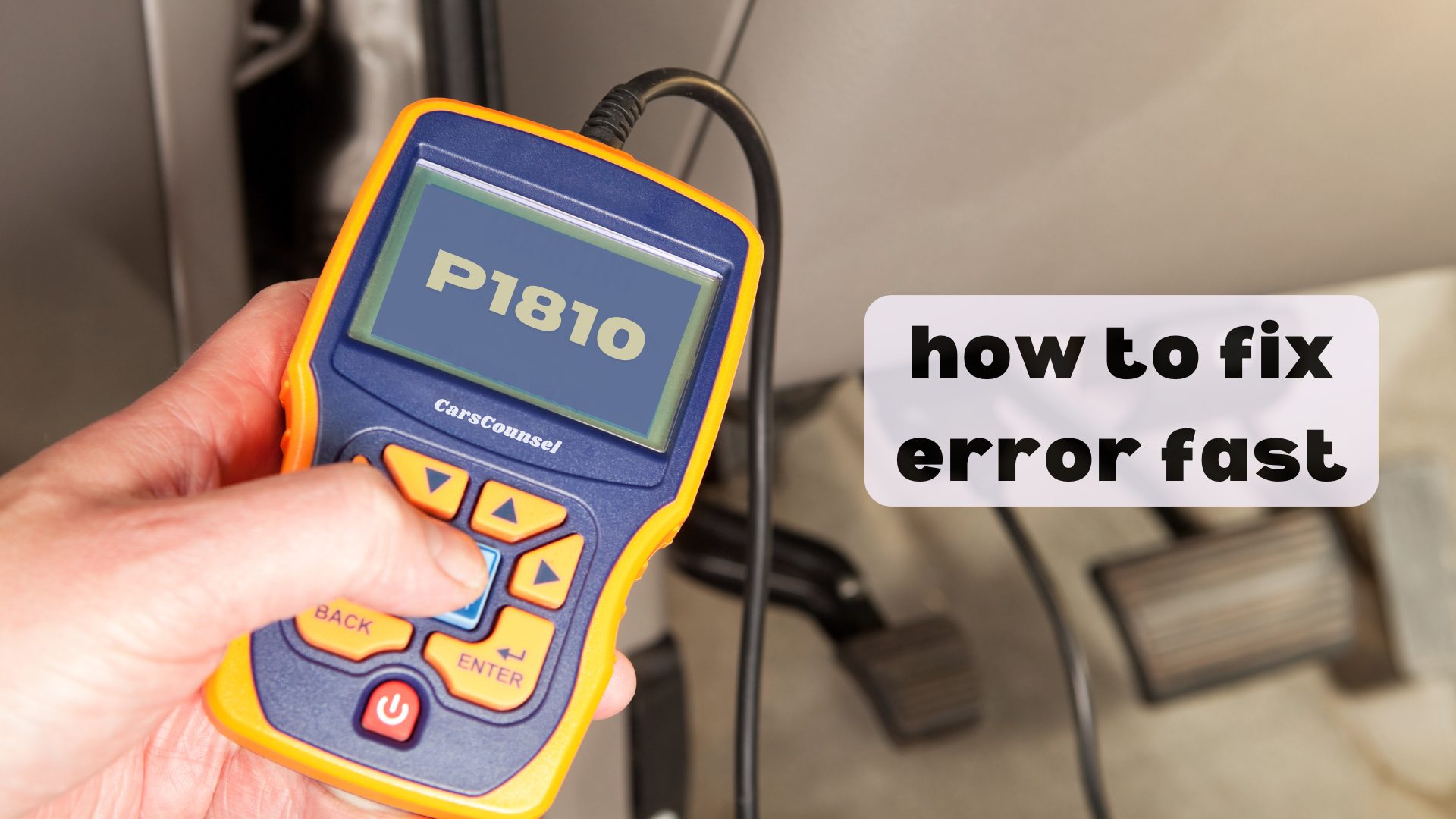When you see the P1300 code, it means there’s a problem with your ignition system that needs quick attention to prevent further issues.
To fix this error quickly, start by using a diagnostic scan tool to confirm the trouble code and spot any other possible problems.
Focus on checking the ignition coils and spark plugs first, as they are often the main issues.
Also, make sure to inspect the wiring and connectors for any signs of wear or corrosion.
If these steps don’t solve the problem, there’s more you can do to keep your engine in good shape.

Quick Navigation
Key Takeaways
- Replace faulty ignition coils: Look at the ignition coils, and if any are damaged, swap them out to fix the P1300 code quickly.
- Check and replace spark plugs: Make sure the spark plugs are clean and in good shape to avoid misfires and fix the error.
- Inspect wiring and connectors: Check for any damaged or corroded wires and connectors in the ignition system and fix them.
- Use a diagnostic tool: Plug in a scan tool to the OBD-II port to find and clear the P1300 code and related problems.
Understanding the P1300 Code
The P1300 code tells you there’s a problem with your car’s ignition system, specifically with the ignition coils. This code means the car’s computer has found an issue in the ignition coil circuit.
It’s important to check your ignition coils for any wear or damage. If needed, replace the faulty coils to make sure your engine gets the right spark to ignite the fuel.
Fixing the P1300 code quickly can prevent more serious damage to your ignition system and keep your car running smoothly. Ignoring it might lead to engine misfires and lower fuel efficiency, so it’s important to take care of it right away.
Significance of Ignition Coils
Ignition coils are super important for your car’s engine. They take the battery’s low voltage and turn it into the high voltage needed to create a spark in the spark plugs. This is crucial for starting the engine and keeping it running smoothly. Regularly checking and maintaining your ignition coils can prevent engine misfires and damage. Here’s a simple guide:
| Part | What It Does | Maintenance Tip |
|---|---|---|
| Ignition Coil | Turns low voltage into high voltage | Look for cracks |
| Spark Plug | Sparks the fuel-air mix to start engine | Replace every 30,000 miles |
| Wiring | Sends electrical signals | Check for wear and tear |
Keeping these parts in good shape is key to a reliable engine. Regular check-ups can help you avoid sudden breakdowns.
Preventing Ignition System Damage
Taking care of your ignition coils and related parts isn’t just about fixing problems when they happen—it’s about stopping issues before they start. By keeping up with ignition maintenance, you ensure your vehicle runs reliably and your engine lasts longer.
Regularly check your ignition coils, spark plugs, and wiring for any wear or damage. If you see any issues, replace the parts right away to avoid expensive repairs. Clean the connections and use dielectric grease to prevent rust.
Use a multimeter to make sure the ignition coils have the right voltage output. Regular maintenance not only keeps the P1300 code from showing up but also boosts your engine’s performance and fuel efficiency.
Make ignition maintenance a habit to avoid unexpected breakdowns.
Common Causes of P1300
A faulty ignition coil is often the main reason for the P1300 code. When the ignition coil fails, it disrupts the spark needed to ignite the fuel, causing engine misfires.
You’ll need some diagnostic tools to find the exact problem. Besides the ignition coil, other common causes include a malfunctioning PCM (Powertrain Control Module), damaged wiring, or bad connectors. Worn spark plugs can also lead to misfires, triggering the P1300 code.
Using diagnostic tools, you can check these parts for issues. It’s important to fix these problems quickly to avoid more damage to the ignition system and keep your car running well.
Identifying and fixing these issues ensures your engine runs smoothly and efficiently.
Affected Car Models
Some car models often run into problems with the P1300 code, which means you need to stay on top of maintenance and repairs.
Knowing which cars are likely to have this issue can help you catch problems early and keep your engine running well.
The P1300 code usually pops up in cars with weak spots in their ignition systems, such as:
- Toyota Camry: Often has issues with ignition coils.
- Honda Civic: Tends to have problems with spark plugs.
- Nissan Altima: Known for misfires due to ignition parts.
- Toyota Corolla: Also has trouble with ignition coils.
Fixing these problems quickly will keep your car’s ignition system in good shape and stop your engine from running poorly.
Diagnosing the P1300 Code
To figure out what’s causing the P1300 code, you’ll need to use a scan tool to check for misfires in the engine and look at key parts of the ignition system, like the spark plugs and coils.
Start by connecting the diagnostic tool to the vehicle’s OBD-II port. Look to see if there are any other codes that might show what’s wrong.
Check the ignition coils to see if they’re damaged or worn out. Take a look at the spark plugs to see if they’re dirty or worn, which could cause misfires.
Also, make sure the wiring and connectors for the ignition system aren’t corroded or damaged. By following these steps, you can find out what’s causing the P1300 code and fix it accurately and efficiently.
Fixing Ignition Issues
To fix ignition issues, start by replacing any bad ignition coils, which are usually why you get the P1300 code. Keeping the ignition system in good shape ensures your car runs well and avoids more problems.
Follow these steps to replace the coil:
- Disconnect the battery: Always disconnect the battery first to avoid any electrical problems.
- Remove the ignition coil: Find and carefully take out the faulty coil from the engine.
- Check connectors and wiring: Look for any damage or rust that might affect performance.
- Install the new coil: Put the new ignition coil securely in the same spot.
Following these steps will help keep your car running reliably.
Cost of Repairs
Fixing a P1300 code can cost a lot or a little, depending on what’s causing the problem.
If it’s just bad spark plugs or ignition coils, you might only pay between $100 and $300.
But if it’s something more complicated, like a broken PCM or damaged wiring, it could cost up to $1,000.
To get a good idea of the cost, you’ll often need a professional to check it out.
It’s a good idea to talk to a few trusted mechanics to understand the likely expenses and make sure you’re not overpaying.
Always get multiple quotes to ensure the problem is correctly identified and fixed.
Driving With P1300
If you keep driving with a P1300 code, you might end up with serious engine problems and your car won’t run as well. Ignoring this issue can also make driving dangerous and cause a bunch of other issues:
- Engine misfires: Your car might idle roughly and won’t accelerate smoothly.
- Reduced fuel efficiency: You’ll burn more gas and spend more money.
- Catalytic converter damage: Unburned fuel can get too hot and wreck this part.
- Increased emissions: Your car will pollute more.
To keep your engine running well and stay safe on the road, fix the P1300 code as soon as you notice it. Taking care of it right away makes sure your car runs smoothly and helps you avoid expensive repairs later.
Regular maintenance is the secret to keeping your car in good shape for a long time.
Importance of Professional Help
Driving with a P1300 code can be dangerous, so getting help from a professional mechanic is crucial. They can accurately diagnose and fix the problem quickly, preventing more damage to your engine. Mechanics have the expertise, advanced tools, and offer repair warranties, making sure the job is done right.
| Benefits of a Mechanic | Risks of DIY | Repair Warranties |
|---|---|---|
| Expert knowledge | Wrong diagnosis | Guarantee on parts |
| Advanced tools | Incomplete repairs | Coverage on labor |
| Accurate diagnosis | Bigger problems | Peace of mind |
| Saves you time | Safety risks | Cost savings |
| Finds hidden issues | Limited tools | Reliable service |
More OBD-II Codes
Frequently Asked Questions
Can the Weather Affect the Ignition System and Trigger the P1300 Code?
Yes, weather can affect the ignition system and trigger the P1300 code. Moisture and temperature changes can make it hard for the ignition system to work properly, leading to misfires. Regular maintenance can help deal with these weather-related problems.
How Do I Reset the P1300 Code After Repairs?
To reset the P1300 code after making repairs, use an OBD-II scanner. Plug in the scanner, choose the reset option, and clear the error codes. Make sure the repairs are done right so the code doesn’t come back.
Are There Any Specific Driving Habits That Can Prevent Ignition System Issues?
You can avoid problems with your car’s ignition system by driving at a steady speed and using good-quality fuel. Try not to accelerate quickly or brake hard. Make sure to regularly check and replace spark plugs and other parts of the ignition system to keep everything working well.
What Are the Symptoms of a Failing Ignition Coil?
When your ignition coil fails, you’ll notice the engine misfiring a lot, rough idling, and a sudden drop in gas mileage. Get it checked out right away to find the problem and stop the car from getting worse.
Can Aftermarket Ignition Coils Cause the P1300 Code to Reappear?
Yes, aftermarket ignition coils can cause the P1300 code to come back if they’re not good quality or don’t work well with your car. Always check that aftermarket parts meet OEM standards to ensure they work correctly.
Conclusion
You’ve followed the steps and fixed what you could, but what if the P1300 code still won’t go away? The problem might be more complicated than just ignition coils or spark plugs.
It could be the Engine Control Module (ECM) or some complex wiring issue. This is where it can get tricky.
Don’t risk causing more damage—consult a professional mechanic. Their expertise might uncover deeper problems that could save you from expensive repairs later.
The real question is, will you take that important next step?

